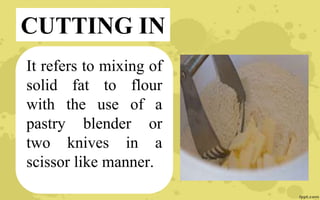mixing techniques
- 2. Mixing accomplishes some of the following: Even distribution of ingredients
- 3. Breakdown of fats and liquids, causing them to emulsify Mixing accomplishes some of the following:
- 4. Mixing accomplishes some of the following: The incorporation of air into a mixture (aeration) to help rise and develop a light texture when baked
- 5. Activation of the proteins in wheat flour , causing the formation of gluten Mixing accomplishes some of the following:
- 6. Definition of Terms âĒ Emulsify â to combine a fat and liquid into a homogenous mixture by properly blending ingredients âĒ Gluten âAn elastic network of proteins created when wheat flour is moistened and manipulated
- 7. Definition of Terms âĒ Aerate âTo incorporate air into a mixture through sifting and mixing âĒ Formula âStandard term used throughout the industry for a bakeshop recipe
- 8. SIFTING
- 9. SIFTING A process of separating coarse particles in the ingredients by passing through a sieve
- 10. CREAMING
- 11. CREAMING Vigorously combining softened fat and sugar while incorporating air
- 12. BLENDING
- 13. BLENDING Mixing the dry ingredients with the liquid ingredients
- 14. KNEADING
- 15. KNEADING The process involves pressing, stretching, folding of doughs to develop gluten.
- 16. STIRRING
- 17. STIRRING Gently mixing of ingredients by a rotating wooden spoon until evenly combined
- 18. BEATING
- 19. BEATING A process that incorporates air into the mixture by mechanical agitation.
- 20. FOLDING
- 21. FOLDING Dry ingredients are sprinkled on top of the fluffy mixture and folded gently and gradually.
- 22. Follow the recipe's instructions properly Use a metallic spoon or a rubber spatula
- 23. Add the delicate mixture to the heavy mixture Use the metallic spoon or spatula in a cutting action
- 24. Continue until both mixtures are adequately combined
- 25. CUTTING IN
- 26. CUTTING IN It refers to mixing of solid fat to flour with the use of a pastry blender or two knives in a scissor like manner.
Editor's Notes
- The techniques used to mix or combine ingredients affect the bakeshop goodâs final volume, appearance and texture.
- ; it gives structure and strength to baked goods and is responsible for their volume, texture and appearance It is formed when the proteins in wheat flour are moistened.
- ; to whip air into a mixture to lighten such as beating egg whites to a foam ; formulas rely on weighing to ensure accurate measuring of ingredients
- like flour and sugar In the process of sifting, air is incorporated.
- Electric mixer with paddle attachment on medium speed: for volume; smooth and fluffy consistency
- Using a spatula, rubber scrapper, wooden spoon: for tenderness
- This refer to pagmamasa or masa in Filipino. This technique makes doughs smooth and elastic.
- This is often done by rotating a wooden spoon through a mixture as long as necessary until the ingredients are combined Over mixing may spoil the texture of many kinds of cakes and muffins. Stirring should be stopped as soon as the ingredients are combined.
- It could be done with a fork, wire whisk or electric food mixer.
- It is a technique most commonly used when you are combining one or more ingredients that have already been whipped (
- Folding is the most efficiently done by hand. This is working with two ingredients very gently to retain air in the mixture. Very gently incorporating ingredients such as whipping cream or whipped eggs into dry ingredients, a batter or cream. If the ingredients to be folded are liquid, pour less fluffy one on top of the another.
- Folding is usually executed with a rubber spatula for liquid and dry ingredients, or with a wire whisk for whipped cream and egg whites so that the mixture gently incorporates as it falls through the wires.
- Cut down through the center of the two mixtures and bring the heavy mixture back up to the top. Baking 911 explains this as the: "down-across-up-and-over motion", which explains it well.[1] Turn the bowl as you are doing this, to ensure that the folding is evenly distributed.
- his is an ideal method for adding beaten egg whites and whipped cream to a heavier mixture. Be sure to fold mixtures together that have the same temperature. For example, room temperature is best for items such as eggs. Batter that is insufficiently folded will leave a sticky, wet layer on the pan base after baking; batter that has been over-folded will inhibit higher rising of the baked item because the air bubbles have been burst.
- This method cuts fat into small pieces, coating them with flour to form coarse, granular mixtures for pastries and biscuits.


























